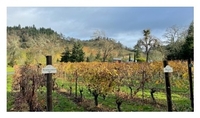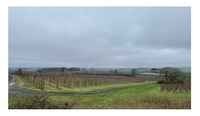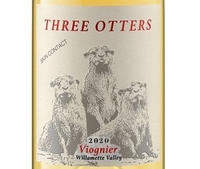If I were to mention a state to you and ask what wine you associate with that region, your answer would likely contain two or three different types. For California, you might say Cabernet Sauvignon and Chardonnay, and for Washington you might say Merlot and Riesling. When it comes to Oregon, though, I’d hazard a guess that most folks would say Pinot Noir, and then scratch their heads for a moment. But the fact is, Oregon has plenty of other wines that are worth seeking out, and a recent trip to both the Umpqua Valley and the Willamette Valley gave me a good look at plenty of things beyond Pinot Noir that are worth seeking out.
With an area of 98,466 square miles, Oregon covers slightly less of the earth than Italy (116,348 sq. mi.), but its forty thousand or so acres under vine are a mere fraction of Italy’s world leading 1.7 million acres of wine grapes. Oregon’s wine producing areas can be divided into 3 major regions: Willamette Valley in the northwest part of the state; Umpqua Valley in the west central zone; and the Rogue Valley in the southwest. There’s also a little bit of overlap of AVA’s generally thought to be in either Washington (Columbia Valley, Walla Walla Valley, Columbia Gorge) or Idaho (Snake River Valley) that cross Oregon’s northern and eastern borders respectively, but they make up less than seven percent of the state’s production – sixty percent or so of which is Pinot Noir.
Which of course leaves forty percent of production to other varieties. Pinot Gris sits firmly in second place at about 14% of total production, largely thanks to the success of King Estate Pinot Gris, which made a huge splash in blind judgings in the late 1990’s and is now a nationwide success. Chardonnay follows at around seven percent, with around 75 other varieties making up the remaining twenty percent of production. With a full seventy five percent of Oregon’s nine hundred plus wineries producing fewer than five thousand cases per year, you might correctly assume that there’s plenty of experimentation going on. Let’s take a look at some of the standouts I’ve discovered from Willamette and Umpqua.
Stephen Reustle’s Umpqua Valley winery, Reustle Prayer Rock

Vineyards, does produce fine Pinot Noir – as do all the properties I’ll touch on here – but his shining star is Grüner Veltliner. The first domestic producer of this Austrian variety offers three different bottlings, and they all have garnered top awards – the 2020 “Estate Selection” shared Best of Show White Wine honors at the 2022 San Diego International Wine & Spirits Challenge in January, not to mention a great review by
WRO editor Michael Franz. Additionally, Reustle offers excellent Malbec, Syrah and Tempranillo.
The current high demand for sparkling wine has spurred many Oregon producers to get into the game. Following the lead of bubbly pioneer Rollin Soles’ Argyle Winery (you’ll find many reviews of Argyle’s sparklers in the
WRO archives), who started up in 1987, many producers have dived in with not only Champagne style fizz made from Pinot Noir and Chardonnay, but other interesting iterations as well. Reustle Prayer Rock’s fourth iteration of Grüner Veltliner is a sparkler called Addie’s Sparkles, and it seems a natural extension for the variety. Left Coast winemaker Joe Wright has a couple of unique sparkling offerings, including the “Queen Bee Bubbly” – a Pet-Nat style sparkling Pinot Noir finished with a honey dosage collected from estate beehives. (Because of ever interesting beverage laws, you’ll have to go to Oregon to get this one.) The honey comes through the apple and grapefruit clearly, finishing dry and pleasantly rich.

Neighboring Johan Vineyards also offers a Pet-Nat from 100% Pinot Noir that delivers a yeasty ,wild strawberry vibe with complementary spice and bay leaf notes. And I’d be remiss not to mention Lytle-Barnett, whose 2015 Brut and 2016 Brut Rosé I recently reviewed with big numbers attached. Johan doesn’t stop there either, producing both a Melon de Bourgogne and a Blaufrankisch that are both worthy of note:
Johan Vineyards (Van Duzer Corridor, Willamette Valley, Oregon) Melon de Bourgogne 2019, $28: This tribute to ripe style Muscadet spent 36 hours on skins before resting sur lie for ten months in barrel. The result is soft grilled peach aromas and flavors with a clear briny note that's perfect for seafood. There's some viscosity here that helps hold the flavors up mid palate, and the extended skin contact adds a little grip and some leafy herb notes. Pass the oysters.
90
Johan Vineyards (Van Duzer Corridor, Willamette Valley, Oregon) Blaufrankisch 2018, $36: This Austrian variety, often referred to as Lemberger, is a parent of two other varieties - Zweigelt and Gamay – and you’ll see the connection when tasting this delicious offering. It spent 11 months in neutral oak, enabling the Gamay-like mixed red fruit aromas and little leafy herb notes to shine. A palate of red and blue berry fruit follows, with bay leaf and white pepper adding depth. A zesty finish keeps it all together. I expect to see more of this variety from Oregon producers based on this success.
92
Riesling is another variety that we’ll no doubt be seeing more of, with a few offerings ready for a star turn. Excellent examples can be found from Firesteed and Reustle Prayer Rock and, as it turns out, Argyle, which has quietly been making small but world stage worthy amounts for some time now. Some current reviews:
Argyle (Eola-Amity Hills, Willamette Valley, Oregon) Riesling “SpiritHouse” 2019, $45: Argyle has only 2.5 acres of Riesling planted, but it gets the prestige treatment as winemaker Nate Klostermann’s favorite grape. Two bottlings are made; this one is done in the dry style, with a solid stony mineral core carrying white flowers, lime zest, nectarine, a dash of petrol and varietally correct spice notes. This is perfectly drinkable right now, but it will go long – twenty years is not out of the question.
95
Argyle (Eola-Amity Hills, Willamette Valley, Oregon) Riesling “NutHouse” 2019, $35: This shows more apricot than the SpiritHouse bottling from 2019, and a touch of RS, but has the acidity to keep it on the dry side of off dry. The vineyard signature markers of lime zest and stone minerality remain intact, and the wine finishes long with mouth-watering intensity. This one also has a long life ahead.
95
A couple more below-the-radar varieties made an impression on me – one that I had sought out, and one that was a complete surprise. First, Pinot Meunier – Champagne’s third grape (mostly grown as a hedge against spring frosts or used to add a dimension to sparkling wine, but charming in its own right) is getting its due at Left Coast Estate with three iterations – a sparkler, a rosé and a red:
Left Coast Estate (Willamette Valley, Oregon) Brut Rosé of Pinot Meunier 2016, $55: This bubbly is 100% Pinot Meunièr harvested from the Field of Dreams block at the cool end of the estate’s vineyards. It shows lively floral and shortbread aromatics, with soft strawberry and a little zesty character. It’s very creamy on entry, with a bright acidic pop on the end, delivering mixed berry fruit, lemon zest and finely tuned toasty notes, It’s long and crisp on the finish – more of this, please!
94
Left Coast Estate (Van Duzer Corridor, Willamette Valley, Oregon) Rosé 2020, $24: This is a “Pinot Trio” of sorts, featuring Pinot Meunier, Pinot Noir and Pinot Blanc. There’s a midpalate richness here that’s unusual for a rosé thanks to full malolactic plus 100% barrel fermentation. Aromas of cherry and watermelon translate with good palate weight, and some dried herb and pepper add depth. A zesty kiss finishes things, but you won’t be finished until the bottle is gone.
92
Left Coast Estate (Willamette Valley, Oregon) Pinot Meunier “High Acres” 2017, $53: This wine isn’t made in every vintage (winemaker Joe Wright says its way more difficult than Pinot Noir) catches all the disease/or other issues first. The 2017 worked out, and it shows a deep cherry nose with earthy touches and a delicate powdery note. The palate is plush, delivering the dark cherry fruit with soft oak spice and damp earth notes, supple texture and a long finish that shows a moderate grip and good integration. The richness is very attractive, even from what Wright described as a lighter vintage. Love this!
93
I’m told both Eyrie and WIllaKenzie are producing varietally labeled Pinot Meunier – I hope to check them both out soon.
At the risk of going long here, there’s one more wine to mention – a Viognier. This and other white Rhône varieties have performed well in the Rogue valley, but this one is from the Willamette:
 Fullerton (Willamette Valley, Oregon) Skin Contact Viognier, “Three Otters” 2020
Fullerton (Willamette Valley, Oregon) Skin Contact Viognier, “Three Otters” 2020, $22: This wine spent 60 days on the skins, sat un-fined in neutral barrels for eleven months and was racked to tank and bottled hazy. It’s wildly aromatic, showing intense honeysuckle and candied fruit on the nose. It’s very dry on the palate, with just a touch of smoky character showing through lemon curd and stonefruit flavors. This is one of the few “orange” wines about which I can say, “I see the point.”
90
I hope all this whets your appetite for a visit to Oregon – especially now that travel restrictions seem to be easing – for more than Pinot Noir alone. Thanks to fellow seeker LM Archer and to Emily Petterson at EKP Media for steering me in good directions. More Oregon reviews will be posting in the coming weeks – stay tuned!